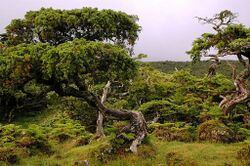Biology:Juniperus brevifolia
| Juniperus brevifolia | |
|---|---|

| |
| Juniperus brevifolia on the humid montane dwarf forests of Pico Island | |
| Scientific classification | |
| Kingdom: | Plantae |
| Clade: | Tracheophytes |
| Clade: | Gymnospermae |
| Division: | Pinophyta |
| Class: | Pinopsida |
| Order: | Cupressales |
| Family: | Cupressaceae |
| Genus: | Juniperus |
| Section: | Juniperus sect. Juniperus |
| Species: | J. brevifolia
|
| Binomial name | |
| Juniperus brevifolia (Seub.) Antoine
| |
Juniperus brevifolia, the Azores juniper, is a species of juniper, endemic to the Azores (on Corvo, Faial, Flores, Pico, Santa Maria, São Jorge, São Miguel, and Terceira), where it occurs at altitudes of 240–800 metres (790–2,620 feet), rarely up to 1,500 m (4,900 ft). It is closely related to Juniperus oxycedrus (prickly juniper) of the Mediterranean region and Juniperus cedrus (Canary Islands juniper) of the neighboring Macaronesian islands. It is threatened by habitat loss.[2][3][1]
It is a shrub or small tree growing to a height of 6 m (20 ft) and a trunk diameter up to 50 centimetres (20 in). The leaves are evergreen, needle-like, in whorls of three, glaucous green, 4–10 millimetres (1⁄4–1⁄2 in) long and 1–3 mm broad, with a double white stomatal band (split by a green midrib) on the inner surface. It is dioecious, with separate male and female plants. The seed cones are berry-like, green ripening in 18 months to orange-red with a variable pink waxy coating; they are spherical, 6–9 mm diameter, and have three or six fused scales in one or two whorls of three, the three larger scales each with a single seed. The seeds are dispersed when birds eat the cones, digesting the fleshy scales and passing the hard seeds in their droppings. The male cones are yellow, 2–3 mm long, and fall soon after shedding their pollen in early spring.[2][3]
This is a vulnerable species in its native range due to a combination of historical felling for the valuable wood and competition from invasive introduced plants.[1]
Habitat fragmentation
On the island of Graciosa, Juniperus brevifolia has gone extinct, and on the other islands, it remains endangered.[4] The decline in population is due to habitat fragmentations of its preferred habitat (laurel forest) caused by island colonization and grazing pressures.[4][5]
References
- ↑ 1.0 1.1 1.2 Thomas, P. (2011). "Juniperus brevifolia". IUCN Red List of Threatened Species 2011: e.T30326A136559787. doi:10.2305/IUCN.UK.2011-1.RLTS.T30326A9536313.en. https://www.iucnredlist.org/species/30326/136559787. Retrieved 1 November 2023.{{cite iucn}}: error: |doi= / |page= mismatch (help)
- ↑ 2.0 2.1 Adams, R. P. (2004). Junipers of the World. Trafford. ISBN:1-4120-4250-X
- ↑ 3.0 3.1 Farjon, A. (2005). Monograph of Cupressaceae and Sciadopitys. Royal Botanic Gardens, Kew. ISBN:1-84246-068-4
- ↑ 4.0 4.1 Bettencourt, Sílvia Xavier; Mendonça, Duarte; Lopes, Maria Susana; Rocha, Sara; Monjardino, Paulo; Monteiro, Lisandra; da Câmara Machado, Artur (April 2015). "Genetic diversity and population structure of the endemic Azorean juniper, Juniperus brevifolia (Seub.) Antoine, inferred from SSRs and ISSR markers" (in en). Biochemical Systematics and Ecology 59: 314–324. doi:10.1016/j.bse.2015.02.003. https://linkinghub.elsevier.com/retrieve/pii/S0305197815000502.
- ↑ Fernández-Palacios, José María; de Nascimento, Lea; Otto, Rüdiger; Delgado, Juan D.; García-del-Rey, Eduardo; Arévalo, José Ramón; Whittaker, Robert J. (10 December 2010). "A reconstruction of Palaeo-Macaronesia, with particular reference to the long-term biogeography of the Atlantic island laurel forests". Journal of Biogeography 38 (2): 226–246. doi:10.1111/j.1365-2699.2010.02427.x. http://dx.doi.org/10.1111/j.1365-2699.2010.02427.x.
Wikidata ☰ Q1702741 entry
 |



